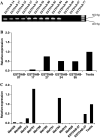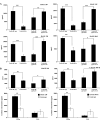HAGE, a cancer/testis antigen with potential for melanoma immunotherapy: identification of several MHC class I/II HAGE-derived immunogenic peptides
- PMID: 17487488
- PMCID: PMC11030838
- DOI: 10.1007/s00262-007-0331-2
HAGE, a cancer/testis antigen with potential for melanoma immunotherapy: identification of several MHC class I/II HAGE-derived immunogenic peptides
Abstract
There remains a need to identify novel epitopes of potential tumour target antigens for use in immunotherapy of cancer. Here, several melanoma tissues and cell lines but not normal tissues were found to overexpress the cancer-testis antigen HAGE at the mRNA and protein level. We identified a HAGE-derived 15-mer peptide containing a shorter predicted MHC class I-binding sequence within a class II-binding sequence. However, only the longer peptide was found to be both endogenously processed and immunogenic for T cells in transgenic mice in vivo, as well as for human T cells in vitro. A different class I-binding peptide, not contained within a longer class II sequence, was subsequently found to be both immunogenic and endogenously processed in transgenic mice, as was a second class II epitope. These novel HAGE-derived epitopes may contribute to the range of immunotherapeutic targets for use in cancer vaccination programs.
Figures






Similar articles
-
The helicase HAGE expressed by malignant melanoma-initiating cells is required for tumor cell proliferation in vivo.J Biol Chem. 2012 Apr 20;287(17):13633-43. doi: 10.1074/jbc.M111.308973. Epub 2012 Mar 5. J Biol Chem. 2012. PMID: 22393060 Free PMC article.
-
The helicase HAGE prevents interferon-α-induced PML expression in ABCB5+ malignant melanoma-initiating cells by promoting the expression of SOCS1.Cell Death Dis. 2014 Feb 13;5(2):e1061. doi: 10.1038/cddis.2014.29. Cell Death Dis. 2014. PMID: 24525737 Free PMC article.
-
Immune responses to a class II helper peptide epitope in patients with stage III/IV resected melanoma.Clin Cancer Res. 2004 Aug 1;10(15):5004-13. doi: 10.1158/1078-0432.CCR-04-0241. Clin Cancer Res. 2004. PMID: 15297401 Clinical Trial.
-
Direct identification of human tumor-associated peptide antigens and a preclinical model to evaluate their use.Cancer J. 2000 May;6 Suppl 3:S272-80. Cancer J. 2000. PMID: 10874498 Review.
-
The use of HLA class I tetramers to design a vaccination strategy for melanoma patients.Immunol Rev. 2002 Oct;188:155-63. doi: 10.1034/j.1600-065x.2002.18814.x. Immunol Rev. 2002. PMID: 12445289 Review.
Cited by
-
HAGE, a cancer/testis antigen expressed at the protein level in a variety of cancers.Cancer Immun. 2010 Jan 11;10:2. Cancer Immun. 2010. PMID: 20058853 Free PMC article.
-
Modified tumour antigen-encoding mRNA facilitates the analysis of naturally occurring and vaccine-induced CD4 and CD8 T cells in cancer patients.Cancer Immunol Immunother. 2009 Mar;58(3):325-38. doi: 10.1007/s00262-008-0556-8. Epub 2008 Jul 29. Cancer Immunol Immunother. 2009. PMID: 18663444 Free PMC article.
-
The androgen receptor: a biologically relevant vaccine target for the treatment of prostate cancer.Cancer Immunol Immunother. 2013 Mar;62(3):585-96. doi: 10.1007/s00262-012-1363-9. Epub 2012 Oct 30. Cancer Immunol Immunother. 2013. PMID: 23108626 Free PMC article.
-
Tumour-associated antigens: considerations for their use in tumour immunotherapy.Int J Hematol. 2011 Mar;93(3):263-273. doi: 10.1007/s12185-011-0783-1. Epub 2011 Mar 1. Int J Hematol. 2011. PMID: 21360066 Review.
-
Human prostate tumor antigen-specific CD8+ regulatory T cells are inhibited by CTLA-4 or IL-35 blockade.J Immunol. 2012 Dec 15;189(12):5590-601. doi: 10.4049/jimmunol.1201744. Epub 2012 Nov 14. J Immunol. 2012. PMID: 23152566 Free PMC article.
References
-
- Disis ML, Gralow JR, Bernhard H, Hand SL, Rubin WD, Cheever MA. Peptide-based, but not whole protein, vaccines elicit immunity to HER-2/neu, oncogenic self-protein. J Immunol. 1996;156:3151–3158. - PubMed
-
- Dissanayake SK, Tuera N, Ostrand-Rosenberg S. Presentation of endogenously synthesized MHC class II-restricted epitopes by MHC class II cancer vaccines is independent of transporter associated with Ag processing and the proteasome. J Immunol. 2005;174:1811–1819. - PubMed
Publication types
MeSH terms
Substances
LinkOut - more resources
Full Text Sources
Other Literature Sources
Medical
Molecular Biology Databases
Research Materials
Miscellaneous

